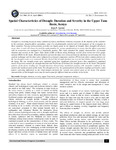| dc.description.abstract | Drought is a recurring hazard in many countries of Africa, and Kenya is thus no exception. In the majority of the countries
in the continent, drought affects agriculture, since it is predominantly rain-fed and is the mainstay of the economies in
these countries. Various socioeconomic activities are highly prone to the impacts of drought. Since drought will always
occur, there is and will always be need for understanding its various manifestations to ensure that the effects associated
with its occurrence are managed in a sustainable manner. This study examined the spatial characteristics of drought
duration and severity in the Upper Tana Basin (UTB) of Kenya using discharge records from twenty two river gauge
stations (RGSs) in the basin. Drought duration and severity data were extracted from the discharge records using the runs
analysis technique and the data series subjected to principal components analysis (PCA) from which common factors for
the two drought events were examined. Results showed that drought duration and severity had distinct spatial patterns in
the basin. The two drought events were explained using four significant principal factors that cumulatively explained
nearly 59 percent variance for drought duration and 56 percent of variance for drought severity in the basin. The spatial
patterns of the factor loadings for drought duration showed large meridional patterns with anomalies confined to the
eastern and southeast parts of the basin. For drought severity, the spatial patterns of the factor loadings portrayed a zonal
pattern reflecting differences in the relief features between the western and eastern parts of the basin. The spatial
characteristics of the drought events may be used to plan for different land use activities in the basin. | en_US |

